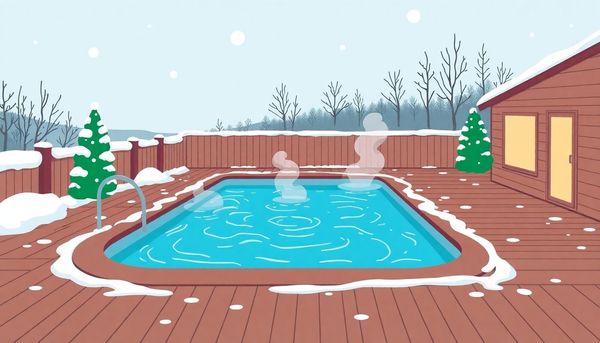Winterize Your Inground Pool: 9 Steps for Easy Spring Prep
March 29th, 2024
March 29th, 2024
The end of summer brings more than just cooler winds and shorter days; it signals the time to prepare your backyard oasis for its winter slumber. For those who cherish their inground pools, closing them properly is crucial to ensuring a hassle-free reopening when the sun returns. One could compare this process to tucking a beloved book away on a shelf, knowing it will be ready to delight again later.
A methodical approach to closing your pool not only protects your investment from the harsh elements but also prevents unwelcome surprises come spring. Whether it’s your first time or you’ve been through this dance of hoses, covers, and chemicals before, each step requires attention to detail. When I first closed my pool, I learned the hard way that skipping a step can turn into a headache months later. Nobody enjoys the surprise of cracked tiles or murky water.
To guide you through this, we’ll explore a straightforward, nine-step method to ensure your pool emerges unscathed from the depths of winter. From balancing chemicals to ensuring your equipment is safely stowed, each step plays a critical role. So, let’s embark on this journey to keep your blue lagoon pristine. This guide will arm you with the knowledge to face the frosty months with confidence, all the while dreaming of that first splash of the season.

Just as the leaves start to fall and the air turns crisp, preparing your pool for winter becomes crucial. It's akin to tucking in your pool for a long, cold nap. First, begin by cleaning your pool thoroughly. A friend once told me how she spent a Saturday morning scraping algae off the walls, only to realize later that her pool had been harboring a mini ecosystem! A thorough scrub ensures you don’t discover such surprises come spring.
Next, consider the chemical balance of your water. You wouldn’t want to wake up a pool with water chemistry that’s gone haywire over the winter. Properly balanced pH and alkalinity levels help ward off corrosion and scale buildup. Remember, using a winterizing chemical kit can prevent algae growth and protect against staining from metals.
Once the chemistry is sorted, think about reducing the water level. This isn’t about draining the pool dry, just enough to accommodate winter's freeze-thaw cycles without causing damage. A golden rule to follow: lower the water below the skimmer line. This prevents freeze damage, which could otherwise lead to costly repairs.
Finally, securely cover your pool. Whether you choose a safety cover or a standard winter cover, make sure it fits well. This barrier protects your water from debris and prevents accidental falls into the pool. During a particularly snowy winter, a friend of mine learned this lesson the hard way when her pool cover caved under the weight of snow. Avoid such mishaps by regularly checking the cover’s integrity throughout the season.
By following these steps, you’re not just closing your pool; you’re ensuring it wakes up ready for another summer of fun.
As the leaves begin to fall and that familiar nip fills the air, it's time to shift focus to the maintenance of your inground pool. Before anything else, embark on a mission to clean your pool thoroughly. This might seem like an obvious step, but consider it the cornerstone of effective pool closure. Imagine trying to cook in a kitchen that hasn’t been tidied up; it's not just inefficient, but can lead to bigger headaches down the line.
Start with a robust brushing of the pool walls and floor, reaching every nook and cranny. This dislodges any persistent grime and early algae spores that might have snuck in unnoticed. Armed with a telescoping pole attached to a sturdy pool brush, you’ll find it easier to scrub off any stubborn residues. It's not just about vanity—removing these potential troublemakers now ensures a cleaner start when pool season rolls around again.
Next, let the vacuum play its part. This isn’t the time to rely on an automatic cleaner; manual vacuuming allows you to painstakingly target and remove all the loosened debris. Pay special attention to corners and steps, where debris often gathers. On a personal note, after a thorough session, I found that my pool not only sparkled under the sun but also required fewer chemicals, saving both time and money when reopening in the spring. So, by ensuring your pool is spotless now, you're setting the stage for a hassle-free welcome back to summer splashes.
When it comes to ensuring your pool's longevity and ease of reopening, the chemistry of the water is your secret weapon. Think of it as the invisible guardian of your pool's health throughout the cold months. Before you start winterizing, take out your trusty test kit or head to a pool store for a water sample analysis. Ensuring your pH, alkalinity, and calcium hardness levels are just right can prevent corrosion and scale build-up. This is crucial because neglecting these levels is like forgetting to brush your teeth for months—problems are bound to arise.
Now, here's a little personal insight. One year, I thought I could skip this step, eager to just throw on the pool cover and be done with it. Come spring, I was met with murky water and surfaces that looked like they'd seen better days. Lesson learned: balanced water in the fall means sparkling water in the spring.
Once your levels are balanced, address the chlorine. Ensure it's below five parts per million (ppm) to avoid it interfering with other chemicals you'll add. Speaking of chemicals, a non-chlorine shock is ideal. It works quickly, allowing you to move on to the next steps without delay. You might also consider adding a metal sequestrant if your water has high metal content, like well water. This prevents unsightly stains on your pool’s surfaces.
Balancing your pool's water chemistry before closing isn't just a checkbox in the winterizing process—it's an investment in a hassle-free opening when the sun returns.
When you finally decide to retire your pool for the winter, investing in a reliable winter cover isn’t just an option—it’s essential. One might think of it as a protective shield, guarding against the harsh elements and preserving all the hard work you've poured into maintaining your pool all summer. For those who’ve ever lifted a cover come spring only to be met with murky, algae-ridden water, the value of a good winter cover is undeniable.
Choices abound when it comes to selecting the right cover for your pool. Solid covers are popular for their ability to keep out debris and sunlight, which can promote algae growth. They are generally more robust, but require a pump to clear any accumulated water. Mesh covers, on the other hand, allow rainwater and snowmelt to pass through while filtering out larger debris. However, they may necessitate monitoring water levels more closely throughout the season.
One autumn, I underestimated the weight of a simple tarp and cheap weights, thinking they'd suffice. By mid-winter, after a particularly blustery storm, I found my makeshift cover half submerged—a soggy invitation for leaves and twigs. That year taught me that securing the cover properly with water bags or cover weights is crucial to avoid similar mishaps.
Ultimately, the right winter cover and meticulous installation can significantly reduce your workload when the pool season rolls around again. It’s an upfront investment of both time and money that pays off with sparkling clean water, ready for the first dive of summer.

A crackling breeze sweeps across your yard, signaling the time to safeguard your pool from winter’s chill. As you ready your inground pool for its hibernation, the cover becomes your first line of defense against algae—the unwelcome guest that thrives in neglected waters. Just last year, a friend learned this the hard way, dealing with a swamp-like mess come springtime. Thankfully, covering your pool properly can mitigate such nuisances.
Choosing the right cover is crucial. Solid pool covers are excellent at keeping out debris, which can decompose over winter and invite algae blooms. A solid cover will also block sunlight—a key ingredient in algae growth. On the other hand, mesh covers let water through, which means you might need to take extra precautions, such as adding a winter dose of algaecide before closing.
Installation requires keen attention to detail. Make sure the cover fits snugly over the pool, with no gaps where leaves or debris can sneak in. Secure it with water bags or cover weights to prevent it from dislodging in heavy winds. Regularly check your cover throughout the season. A simple sweep with a broom or a gentle rinse can keep it clean and functioning well.
By investing time in properly covering your pool, you’re ensuring a clearer, cleaner start when the sun beckons you back to the water next season. Your future self will thank you, skipping the battle with stubborn algae as you dive straight into fun.
Closing your pool properly is more than just a seasonal task; it's an investment in next year's fun. The pool cover plays a pivotal role in ensuring that investment pays off. It's not just a protective shield against debris; it's your pool's winter coat, safeguarding it from the harsh off-season elements. When choosing your cover, make sure it fits snugly. Avoid any sagging or gaps where leaves, rainwater, or even small critters might sneak in. A tightly fitted cover preserves the chemical balance you've worked hard to achieve before closing.
Take a moment to consider the weight of winter. Snow and rain can accumulate, turning a flimsy cover into a dangerous burden. Equip yourself with a pool cover pump to keep water from pooling. This small step can prevent tears and extend the life of your cover. Using water bags or anchors along the edges can further secure it, ensuring it stays in place no matter what the season throws at it.
To keep your pool cover in peak condition, regular check-ins are key. Brush off leaves and debris with a gentle broom; there's no need for aggressive tools that might puncture or tear the material. For those in snowy areas, a soft broom will suffice to clear away light snowfalls. By maintaining your pool cover throughout the winter, you set the stage for an easier, smoother opening when the sun returns.
Closing your pool is much like preparing your home for winter—the methods you choose should suit the climate you live in. When I first moved from a mild to a more frigid area, I learned the hard way that one size does not fit all when it comes to winterizing pools. The following tips will help you avoid similar pitfalls.
If winter in your region brings freezing temperatures, it's crucial to drain your pool's pump, heater, and plumbing lines completely. Any leftover water can freeze and expand, leading to costly cracks and leaks. On the contrary, residents in warmer climates like Southern California might skip this step, instead running the pool pump daily to keep the water circulating.
For those facing harsh snowy conditions, a durable winter cover is non-negotiable. These covers shield your pool from debris and prevent water buildup. If your climate is milder, a lighter cover may suffice, or consider using a mesh cover that allows rainwater to pass through while keeping leaves and twigs out.
Chemical balance also varies by climate. In colder regions, using a pool antifreeze designed for temperatures below your local lows is essential. Conversely, in warm areas, you might rely on pool enzymes to break down organic contaminants, maintaining water clarity through the winter months.
By tailoring your closing techniques to your environment, you ensure that your pool emerges from its winter slumber in pristine condition, ready for another season of fun.
Balanced water chemistry is the unsung hero of pool maintenance, especially when preparing for the offseason. Imagine setting the stage for a seamless pool reopening with just a bit of attention now. To start, testing the water is crucial. Arm yourself with a reliable test kit, much like the one I rely on for my pool, ensuring you check pH, alkalinity, and calcium hardness. These elements, when balanced, protect pool surfaces from the ravages of corrosion and scale, making water chemistry akin to shield armor for your beloved oasis.
Once the tests are complete, adjust the pH levels to sit comfortably between 7.2 and 7.6. This sweet spot minimizes irritation to the skin and eyes and boosts the efficiency of other chemicals. Meanwhile, alkalinity should hover in the range of 80-120 parts per million (ppm), acting as a buffer to prevent wild fluctuations in pH. For calcium hardness, a range of 200-400 ppm is ideal, safeguarding against etching and scaling.
The role of chlorine cannot be understated; it is your main line of defense against algae and bacteria. Lower its level to below five ppm before proceeding with other winterizing chemicals. High chlorine levels could neutralize these additives, rendering them ineffective. Finally, consider using a metal sequestrant if your water source is prone to high metal content. This simple step can prevent those stubborn, unsightly stains that might greet you come spring.
With these adjustments, your pool is not just closing; it's hibernating gracefully, ready to awaken fresh and inviting in the warm months ahead.

Venturing into the realm of pool maintenance, there's a crucial step that holds the power to transform your pool's off-season fate: balancing the water chemistry. This task might sound as thrilling as watching paint dry, but trust me, it's the unsung hero of a successful pool closure.
Think of it as preparing your pool for hibernation. Start by testing your water's pH, alkalinity, and calcium hardness. You’ll want these levels to be just right—like Goldilocks’ porridge—not too high, not too low. An imbalanced pool can lead to corrosion and scale buildup, wreaking havoc on pool surfaces and equipment.
Once, a friend of mine skipped this step, thinking it unnecessary. The result? A springtime surprise of stained tiles and a hefty repair bill. Don't be that friend. By taking the time to adjust your pool's chemistry, you're safeguarding it against potential damage and ensuring a smooth reopening.
Add a winter algaecide and a metal sequestrant to protect against spore growth and metal staining. These additives keep unwanted guests like algae and metals at bay, preserving your pool's pristine condition through the colder months. So, before throwing on that pool cover, give your water the care it deserves. Balance is everything, and in this case, it’s the difference between a swampy mess and a crystal-clear oasis come spring.
A crisp autumn breeze carries the promise of cooler months ahead, a gentle reminder it's time to cocoon your pool for its winter slumber. Ensuring the pool cover is properly installed plays a crucial role in safeguarding your aquatic investment. Whether it's your first closing or you're a seasoned pro, the right cover can make all the difference between a sparkling pool or a murky disaster come spring.
Start with a thorough inspection of the cover. Ensure it's free of rips or tears, and the seams are intact. A friend of mine once learned the hard way—ignoring a small tear resulted in a cover-turned-sieve, welcoming leaves and rain to brew a winter concoction best left to witches. Avoid this by patching any damage before laying the cover across your pool.
Secure the cover snugly using water tubes or weights according to the manufacturer's instructions. This step isn’t just about keeping the cover in place; it prevents wind from turning it into a sail, which could lead to unfortunate accidents or damage. Remember, if snow is a regular winter guest in your town, invest in a cover pump to prevent heavy snow or rain pools from sagging and stressing the material.
Keep an eye on your pool cover throughout the colder months. A quick sweep with a broom (never use sharp tools) of leaves or snow ensures the cover stays in prime condition. Remember, a well-maintained cover isn't just a protector; it's a promise of an easy transition back to sunlit swims when warmer days return.
Winter's approach signals the time to give your pool a much-needed rest. Yet, closing your pool for the season isn't as simple as putting on a cover and walking away. The real secret to an easy spring opening lies in how well you optimize your chemical additives for winter. Think of it as giving your pool a nourishing send-off, ready to hibernate without a hitch.
First, consider algaecides. Algae might seem harmless when the water's chilly, but it's a tenacious foe. A copper-free algaecide acts as an invisible shield, preventing any sneaky spores from setting up camp. If your pool cover lets in dirt and debris, double down with an extra dose. This little step will save you from a swampy surprise come spring.
Next, let’s talk about metals. If your water source is a well, metal sequestrants are your best friend. They bind up the metals, preventing them from causing unsightly stains and protecting your pool's surfaces. It's like having a silent guardian keeping your pool pristine even when it's out of sight.
Finally, integrate pool enzymes into your winter regimen. These additives tackle organic waste, minimizing scum lines and waterline buildup. In essence, they're reducing the workload for your algaecide, ensuring your pool water remains clear and inviting.
Remember, the right chemical balance now will mean less hassle later. By taking the time to optimize your pool's winter chemistry, you'll reward yourself with a clean, ready-to-enjoy pool when the sun warms up once again.
As the chill of winter approaches, one often-neglected task is keeping an eye on your pool’s water levels. This isn’t just a mundane chore; it’s a small action that can prevent significant headaches when spring returns. A good friend once told me about their pool disaster one spring. They hadn't checked their pool's water level all winter. When they finally peeled back the cover, they found that melting snow had turned their pool into an overflowing pond, causing damage to the deck and nearby landscaping.
To avoid such a scenario, regularly monitor your pool’s water level throughout the off-season. Depending on your cover type, aim to keep the water level within a recommended range. For those using a solid cover, ensuring the water sits comfortably below the skimmer or tile line is crucial. This prevents overflow from rain or snowmelt, which can lead to structural damage and additional contamination from surrounding areas.
Furthermore, consistently adjusting the water level means you also safeguard your pool liner or plaster against prolonged exposure to the elements. If water levels drop too low, parts of your pool surface could be left unprotected, potentially leading to cracks or other costly repairs.
In essence, dedicating a few moments every month to check and adjust your pool’s water level can save you time, money, and stress. It might seem minor, but like many things in life, it's the little details that often make the biggest difference.

Winter's chill can be an uninvited guest, especially when it threatens the well-being of your beloved pool equipment. A friend of mine learned this the hard way last year. He thought simply covering the pool was enough, only to discover a frozen pump come spring.
The first step is to safeguard your equipment by properly draining the water. Water left in the pump, filter, or heater can freeze, expand, and cause cracks, leading to costly repairs. Disconnect all equipment, allowing it to drain completely. For added protection, consider using a pool-specific antifreeze for any stubborn spots where water might linger. Remember, automotive antifreeze is a no-go—stick to the non-toxic variety designed for pools.
Next, ensure all accessories such as ladders and skimmer baskets are removed and stored safely away from the elements. This prevents rust and other damage from prolonged exposure. My neighbor once left his ladders in and ended up with unsightly rust stains that took weeks to clean.
Lastly, consider investing in a high-quality cover that fits snugly, keeping snow and debris at bay. It's about peace of mind, knowing the pool is cocooned safely for the winter months. By taking these measures, you not only protect your equipment but save yourself from future headaches, ensuring a smooth start to the next pool season.
Closing an inground pool properly can be the difference between starting the next swim season with a sparkling oasis or a murky nightmare. It's like giving your pool a well-deserved rest after a busy summer, ensuring it's ready to shine again come spring. The key is not just about shutting down but doing so with attention to detail.
First, make sure your pool gets a good cleaning. This means brushing the walls, vacuuming the floor, and skimming out any lingering leaves. I recall once neglecting this step, only to be greeted by a colorful algae bloom that turned opening day into an all-out scrub fest. Trust me, it’s worth the effort to avoid that fiasco.
Next, balancing the water chemistry is crucial. Get your pH, alkalinity, and calcium hardness in check. This helps to prevent any nasty surprises like corrosion or scale buildup. My neighbor once skipped this and ended up with a stained liner that needed expensive repairs. A little time spent now will save you headaches later.
Finally, choosing the right cover is essential. A good fit will protect against debris and prevent evaporation. Consider using water tubes to secure it and prevent gaps; this step is often overlooked but can make a big difference during heavy winds.
By following these steps, you'll ease into the next pool season with minimal fuss, leaving you more time to enjoy the first dive.
As autumn leaves begin to flutter down and crisp air nips at your nose, it’s time to acknowledge that the swimming season is drawing to a close. This transition from sun-drenched days to cooler climates isn’t just a call to swap out swimwear for sweaters; it’s an essential cue to prepare your inground pool for the impending chill.
Start with a thoughtful approach to water chemistry. Balance is key. Adjust the pH, alkalinity, and calcium hardness to recommended levels to stave off corrosion and scale buildup during the dormant months. This step might seem mundane, yet it's the unsung hero in maintaining your pool’s longevity.
Next, consider the power of prevention. When temperatures plunge, the water in your pool can freeze and expand, potentially causing cracks or damage to your pool’s structure. Draining the water to the appropriate level is crucial. A solid rule of thumb is to lower it below the skimmer to prevent freeze damage. In especially frigid regions, blowing out the lines ensures that no water lingers in the plumbing to freeze and expand. If you're unsure about this process, don't hesitate to call in a professional.
Finally, shield your aquatic sanctuary with a reliable cover. A sturdy winter cover protects against debris and unwelcome critters while also safeguarding the water quality you've carefully balanced. Investing in a cover pump will help manage any water accumulation on the surface, preventing sagging and damage.
Closing your pool might feel bittersweet, but with the right steps, you’re setting the stage for a hassle-free reopening when the warmth returns.
Winter may transform your backyard into a snowy wonderland, but it also poses a serious threat to your inground pool if proper steps aren't taken to protect it. A crucial part of winterizing is ensuring your pool lines are safe from freezing. When water left in pipes freezes, it expands, potentially cracking the lines and leading to costly repairs.
To prevent this, start by thoroughly draining all the water from the lines using an air compressor. This tool helps push out any remaining water that might be lurking in hidden bends of the pipes. It's a process best done carefully to avoid applying too much pressure, which could damage the plumbing. If you’re not confident in doing this yourself, calling in a pool professional is a wise move.
For added protection, consider using pool-specific antifreeze. This isn’t the same as the kind you pour into your car; pool antifreeze is non-toxic and specially formulated to work in swimming pool systems. Pour it into the lines after blowing them out to provide an extra layer of security against freezing temperatures.
Remember, the key is to ensure no water is left to freeze. By taking these steps, you’ll safeguard your pool’s plumbing and avoid the unwelcome surprise of costly repairs come spring. It’s a bit of effort now, but you’ll thank yourself later when pool season returns and everything is ready to go with minimal fuss.

When snowflakes start swirling and the days grow colder, pool enthusiasts know it’s time to bid farewell to their beloved backyard oasis for the season. This transition isn’t just about stowing the cover; it’s crucial to safely store all pool accessories to ensure they’re ready for action next summer.
Start with ladders and rails. Not only can prolonged exposure to winter weather cause these metal parts to corrode, but leaving them in place can prevent your pool cover from fitting snugly. Once removed, clean them thoroughly and allow them to dry before tucking them away in a garage or shed, shielding them from harsh elements.
Next, turn your attention to smaller items like pool toys, floats, and cleaning equipment. These often-overlooked accessories can become brittle and brittle in freezing temperatures. A simple rinse and dry will do wonders before storing them in a large, sealable bin. This keeps everything organized and free from dust and debris.
It’s also wise to remove and clean your skimmer baskets, diving boards, and any removable lighting fixtures. Place fittings and screws in labeled bags to avoid misplacing them. If you’ve got a pool vacuum or automatic cleaner, ensure it’s properly drained to fend off mold growth.
By taking a few hours to properly store your pool accessories, you’re investing in their longevity. When the first warm day of spring arrives, you’ll be ready to dive back in without a hitch.
Standing at the edge of your pool, skimmer in hand, you might not give much thought to the tools that help keep your backyard oasis pristine. As the season winds down, however, giving these unsung heroes a little extra TLC can make all the difference when it comes time to reopen. Cleaning and preparing your pool equipment isn’t just a chore—it’s an investment in the longevity of your gear.
Begin with your pool pump and filter. Imagine the layers of grime and debris these have sifted through all summer. By thoroughly cleaning them now, you save yourself from a nasty surprise come spring. Disassemble the filter, whether it’s cartridge, sand, or diatomaceous earth (D.E.), and give it a good soak or backwash. Don't forget to drain the pump of any remaining water to prevent freezing and cracking during those chilly months.
Next, attention turns to hoses and fittings. Ensuring they are clean and dry before storing them away is key. Moisture left behind can lead to mildew or even damage from ice expansion. Coiling the hoses neatly and placing smaller fittings in a labeled box keeps everything organized for swift setup next year.
Electronics like heaters and chlorinators also deserve a moment in the spotlight. Turn off their power, clean off any residue, and tuck them away safely indoors if possible. A little effort now means you'll be greeted by well-functioning equipment when the sun returns and the pool beckons.

This article provided insights into maintaining your pool. Start your pool care journey today!
Want to become a pool maintenance expert? Our free Pool School course covers everything you need to know about pool care. From basic maintenance to advanced troubleshooting, you'll learn how to:
Join over 10,000 pool owners who have already transformed their pool care routine. Get started with our free Pool School course today!